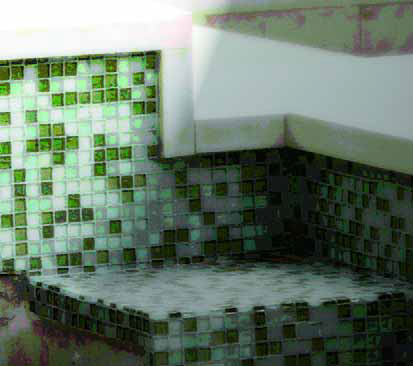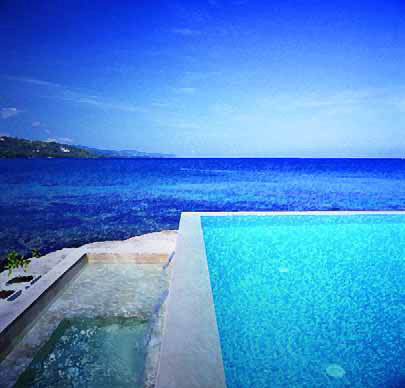tile
When I was a kid, the conventional part of my education in environmental design came in helping my father, Jay Stang, plant parkways and blocks of Pinus Pinea across the city. The unconventional part - the part that apparently took firmer root as I grew up - had me admiring the plate he'd made from hardwood with the dozen split avocado pits he'd carved and mounted on the surface; it also had me listening to my mother, Judy Campbell, tell me that the earth was here first, that the garden already exists and that pathways, watershapes and structures are best built around what we find there. Those unconventional lessons - one about creativity and vision, the other about respect for nature and a method for approaching it - have stayed with me through the years and have given me access to a number of incredible projects. As is the case with most intriguing and fascinating designs, the one seen here flowed from a client with whom I developed a close creative connection that resulted in a free exchange of ideas¬ - a synchronized spontaneity that became a pattern for the entire design process. She always had strong thoughts about what she wanted, but she allowed me to interpret and express her ideas based on our conversations and the nature of the site. As designers, it's not unusual for us to be called on to use our skills and figure out what a client such as this one really wants and then suggest ideas we think will work. I call this process "environmental psychiatry" because, while so many clients have a sense of what they want and a laundry list of general ideas, few have a
When I was a kid, the conventional part of my education in environmental design came in helping my father, Jay Stang, plant parkways and blocks of Pinus Pinea across the city. The unconventional part - the part that apparently took firmer root as I grew up - had me admiring the plate he'd made from hardwood with the dozen split avocado pits he'd carved and mounted on the surface; it also had me listening to my mother, Judy Campbell, tell me that the earth was here first, that the garden already exists and that pathways, watershapes and structures are best built around what we find there. Those unconventional lessons - one about creativity and vision, the other about respect for nature and a method for approaching it - have stayed with me through the years and have given me access to a number of incredible projects. As is the case with most intriguing and fascinating designs, the one seen here flowed from a client with whom I developed a close creative connection that resulted in a free exchange of ideas¬ - a synchronized spontaneity that became a pattern for the entire design process. She always had strong thoughts about what she wanted, but she allowed me to interpret and express her ideas based on our conversations and the nature of the site. As designers, it's not unusual for us to be called on to use our skills and figure out what a client such as this one really wants and then suggest ideas we think will work. I call this process "environmental psychiatry" because, while so many clients have a sense of what they want and a laundry list of general ideas, few have a
All projects come to an end, of course, but there are times when the inevitable takes its own, sweet time. The project featured here, for example, took more than six years from the time I first met the clients until we wrapped things up. Unlike some projects that take a long time because of ongoing problems, change orders and difficult challenges, this one was very much a labor of love from start to finish. Sure, there were some tough spots, but for the most part, this was one of those jobs that we watershapers and landscape professionals can only hope will come along from time to time - projects we don't mind extending through a period of years. This one had everything going for it, starting with great clients who had the resources to do something special as well as playful, fun-loving personalities that made the process exciting and rewarding. Then there was the property: an acre of ocean-view hillside in Brentwood, Calif., with mature trees and a big, Cape Cod-style house that was going through extensive remodeling during the time we were involved with the landscape. The clients wanted something that was elegant but playful, with formal lines and structures but a light overall touch. They insisted on beautiful materials, were heavily involved in every decision and, ultimately, had our firm, New Leaf Landscape of Agoura Hills, Calif., work with
Many of the projects I tackle are largely about beauty and elegance and striking just the right balances between my watershaping and the setting, the architecture of the home and the character of my clients. In the case of the project depicted here, however, a couple of other considerations jumped into the mix - including impulses for fun and excitement as well as an overriding need to raise the visual energy level to align with the clients' personalities and a glorious setting. The result is an exquisitely adorned watershape that stands as one of the purest expressions of whimsy and unbridled joy I've ever produced. Truly, it all flowed from the clients and the setting. The clients are quite educated, well-traveled and sophisticated and had both the resources and the desire to do something special. Moreover, they're about as nice a couple as you could ever hope to meet and had refined tastes to match. As for the setting, we're talking beauty in the extreme: The home is a modern masterpiece perched atop a bluff in Malibu, Calif., with 180-degree ocean views and spectacular distant vistas. The only clinker on the property was the existing pool and the surrounding decks - an aggressively plain, kidney-shaped drag surrounded by equally boring decks. It was time for
In my years as a practicing landscape architect, I've found that designers love in particular to borrow elements from the Spanish Colonial style of architecture. In fact, it has become one of the most important and influential of all architectural forms. This archetypal architecture flourished between the 16th and early-19th centuries in the New World and is based upon historical models established in
Even though color is literally everywhere, most people know surprisingly little about it. That's a knowledge gap designers in particular should overcome, says artist, colorist and teacher Judith Corona, who adds that understanding the nature of color, how it influences moods and emotions and how a color wheel works are all useful when it comes to making valuable recommendations to clients about their watershapes and landscapes.
It's easy to talk about watershapes and the creative and business philosophies that drive success, but to borrow a phrase: The proof is in the pool. In other words, it's one thing to talk about doing a good job, but it's another to step up and do it. The dynamics of that success are unusually complex when you participate in a project as the member of a team. As a case in point, I'll return to a semi-public watershape I first mentioned in my March 2006 column: It's now complete and is one of which I'm particularly proud. Located in Jamaica near Montego Bay at a property known as the Round Hill Hotel & Villas, it was a special sort of commercial project in that, being built outside the United States, it wasn't subject to
As the first columnist among several who will be writing in this space, I've been elected to explain what this "Material World" thing is all about. I agree with the editors that it does require some explaining - but not much. The thought is that we in the landshaping business, designers and installer alike, seldom use a single material all on its own. Even a huge, monolithic concrete deck outside a grand office building will have ribbons of stone or brick to break up the monotony. The aim of this and subsequent articles - whoever writes them - is to discuss the process we go through in selecting plant and/or hardscape material combinations that ultimately work together to become beautiful and seemingly effortless explorations of style, texture and color. In other words, we'll be looking at projects for which all the
'I want the house to look as though it is floating on water." That was what architect Victor Canas told me when I was called out to visit this site on the northwestern coast of Costa Rica. It was a brilliant idea, certainly one that befitted the spectacular mountaintop setting and its breathtaking 360-degree views of rugged coastline, forest greenery and assorted perspectives to horizons in all directions. I had the advantage in this case of
This project was all about fun and finding ways to infuse watershapes and the overall landscape with childlike senses of playfulness and wonder. At a glance, of course, it's obvious that this particular approach wouldn't work for too many clients, but in this case, we were working with a woman who wanted her yard to express her love of color, her sense of humor and her unparalleled inclination toward the unusual. From our first meeting, I knew that this was someone who wouldn't settle for anything that even approached the ordinary. Maybe it was the 12-foot-tall fiberglass chicken she'd placed in her front yard or the life-size hippopotamus in the backyard or her wildly eclectic taste in art and interior furnishings or her fittingly off-beat




















